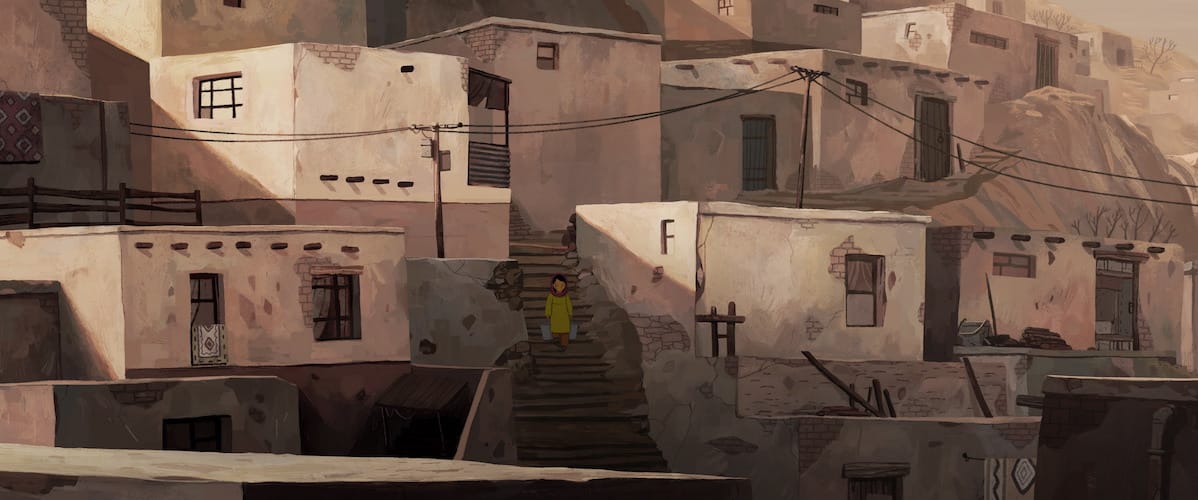What’s the best way to tell area residents about plans for a new asylum shelter nearby?
The government should tell communities directly about plans for new asylum shelters, some activists and politicians say.
Cartoon Saloon’s latest animated feature tells the story of young Parvana’s life under the Taliban. “There is hard work and humanity in every frame,” writes Luke Maxwell.

In Taliban-era Afghanistan, a young girl named Parvana (Saara Chaudry) struggles to provide for her family after her father is wrongly imprisoned.
Adapted from a bestselling children’s novel by Deborah Ellis, The Breadwinner is the new animated feature from Nora Twomey and Cartoon Saloon. And while the setting may be a world away from Irish mythology, this third feature retains the seemingly effortless high quality of the Kilkenny studio’s previous work.
The Cartoon Saloon logo is something of a guarantee of quality for animated feature films. With their previous features, the studio established a strong house style that places them alongside the giants of the animation world. A few more films, and the studio’s logo may well prove as reassuring as Totoro on a blue background, or Mickey Mouse steering a steamship.
The Breadwinner is not as whimsical or as action-packed a film as Cartoon Saloon’s previous offerings. There is, instead, a staid feel to the material.
Colours are muted and realistic. Character design is pleasingly broad, with effective silhouetting on the major players, who look good against the background art. Character animation feels deliberately naturalistic, with eyes being the only element that feels larger than life.
Its low-key approach means that sometimes The Breadwinner doesn’t feel much like an animated feature at all.
The background art shows Afghanistan’s troubled history in every barbed-wire fence, abandoned military vehicle and blown-out building. And the looming threat of jets overhead foreshadows further turmoil to come.
In its depiction of Parvana’s day-to-day life, the direction is delicate and artful. Cuts are infrequent and characters move about the frame in a manner that mimics a live-action feature.
Twomey is particularly fond of showing incidental details that build up a greater sense of the world. Background elements are drawn with exquisite detail. Food, market stalls and architecture are all drawn with great care and help to build a lived-in feeling to the backgrounds.
Cartoon flourishes are used sparingly in the film, most often for facial expressions, but the real-world action always feels grounded and restrained.

When we do see little bursts of cartoonishness set against the film’s almost photorealistic backdrops, the animation really pops, and heightens the emotional impact of the voice work and narrative.
Twomey and her team use contrasting styles to separate the harsh reality of Parvana’s daily life in a Kabul that seems drained of colour, from the hopeful fantasy of the bedtime stories she tells her little brother. The mythical Afghani past seen in those stories is textured like a plush carpet; colours are richer and the animation is allowed to be looser too.
In Parvana’s story about a young man on a quest to retrieve stolen seeds from a monstrous elephant, characters look and move like puppets. They are more rounded than their real-world counterparts and everything has the “squash and stretch” of a classic cartoon in these story sequences.
Parvana’s father, Nurullah (Ali Badshah), was a teacher before the war. As they eek out a living selling bits and pieces in the marketplace at the start of the film, he encourages her to tell stories and engage with her country’s history.
As father and daughter talk, we are presented with a montage showing the numerous invasions throughout Afghanistan’s history.
A soldier riding a horse morphs as history advances from a Mongol to a Persian to a British infantryman right up to the present day. The character design here is excellent. There is continuity in the shape of the invader, but the change in clothes and weaponry gives us an effective overview of of Afghanistan’s turbulent history.
There is a hard edge to this picture that sets it apart from Cartoon Saloon’s previous work and puts The Breadwinner alongside other recent animated features such as Have a Nice Day, Tehran Taboo and Loving Vincent.
For Parvana, everyday tasks are dangerous. She is heckled as she goes to the well to collect water. She must obey a strict curfew, and there is always the sense that for women and girls the threat of violence is a fact of life.
Later, Parvana and her mother attempt to plead her father’s case and are accosted by a soldier on the way to the prison. The camera stays with Parvana as her mother is beaten off-screen. We see nothing of the assault, but we still feel every blow.
When Parvana disguises herself as a boy, she is able to experience a kind of freedom she never knew before, but there are new dangers awaiting her as well. She is mistreated by employers and assaulted by a soldier as part of a macho ritual.
Twomey does not sugar-coat these elements of the story, and the film’s matter-of-fact representation of violence is commendable.
The Breadwinner shows us the essence of human courage. Parvana, who has used storytelling as a shield from the world around her, must face her fears. It’s a good lesson for any child, and calls to mind the children’s author and illustrator Tomi Ungerer’s notion that children must face adversity in order to become courageous.
This is a film that speaks to defiance and resilience and to the strength of the human spirit. The Breadwinner further solidifies Cartoon Saloon’s reputation as a key player in animated films and showcases the skill and ingenuity of Nora Twomey as a director.
There is hard work and humanity in every frame of The Breadwinner, and it’s difficult not to be swept up in its artistry.
The Breadwinner is in cinemas now. A special screening in Irish plays at the IFI on Thursday 31 May at 6:20pm.